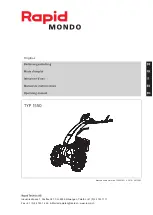
10. Sit on the seat when starting the engine and oper-
ating the machine.
11. On machines equipped with roll-over protection
(ROPS), always use seat belt and ROPS together.
Make sure seat pivot retaining pin is installed.
12. Before starting the engine:
A. Engage parking brake,
B. Make sure traction pedal is in neutral and PTO is
in OFF (disengage) position.
C. After engine is started, release parking brake and
keep foot off traction pedal. Machine must not move.
If movement is evident, the neutral return mecha-
nism is adjusted incorrectly. Shut engine off and
adjust until machine does not move when traction
pedal is released.
13. Do not run the engine in a confined area without
adequate ventilation. Exhaust fumes are hazardous and
could possibly be deadly.
14. Maximum seating capacity is one person. Therefore,
never carry passengers.
15. Check carefully for overhead clearances before
driving under any objects.
While Operating
16. Using the machine demands the operator’s com-
plete attention. To prevent loss of control:
A. Operate only in daylight or when there is good
artificial light.
B. Drive slowly.
C. Avoid sudden stops and starts.
D. Look behind machine before backing up.
E. Watch for holes or other hidden hazards.
F. Do not drive close to a sand trap, ditch, creek, or
hazard.
G. Reduce speed when making sharp turns and
when turning on a hillside
H. The cutting deck must be lowered when going
down slopes for steering control.
17. To maintain machine control, 35 lb. of weight must
be mounted on rear of traction unit before using the
Triflex 88" cutting unit. More weight may be required in
some steeper slope conditions.
18. Operator must be skilled and trained in how to drive
on hillsides. Failure to use caution on slopes or hills may
cause loss of control and vehicle to tip or roll possibly
resulting in personal injury or death.
19. Traverse slopes carefully. Do not start or stop sud-
denly when traversing slopes or when traveling uphill or
downhill.
20. If engine stalls or machine loses headway and
cannot make it to the top of a slope, do not turn machine
around. Always back slowly straight down the slope.
21. The grass deflector(s) must always be installed and
in lowest position on the cutting unit. This product is
designed to drive objects into the ground where they
lose energy quickly in grassy areas. However, don’t take
an injury risk!! When a person or pet appears unexpect-
edly in or near the mowing area, STOP MOWING.
Careless operation, combined with terrain angles, rico-
chets, or improperly positioned guards, can lead to
thrown object injuries. Do not resume mowing until area
is cleared.
22. Never raise the cutting unit or other attached imple-
ment while the blades or other parts are rotating.
23. If cutting blades or other implement components
strike a solid object or the machine vibrates abnormally,
disengage PTO, move throttle to SLOW, set parking
brake, and shut engine off. Remove key from switch to
prevent possibility of accidental starting. Check cutting
unit or other implement and traction unit for damage and
defective parts. Repair any damage before restarting
the engine and operating the implement or cutting unit.
Assure cutting unit blades are in good condition and
blade bolts are torqued to proper specifications (See
Cutting Unit Operator’s Manual).
24. To stop machine, remove foot from traction pedal
and use brakes. Gradually reversing the traction pedal
can provide additional braking.
25. Do not touch engine, muffler, or radiator while engine
is running or soon after it has stopped. These areas
could be hot enough to cause a burn.
26. Lower the cutting unit or other attached implement
to the ground and remove key from switch whenever
machine is left unattended.
Safety Instructions
Page 1 - 2
Groundsmaster
®
300 Series
Summary of Contents for Groundsmaster 328-D
Page 2: ......
Page 12: ...Torque Specifications Page 2 4 Rev A Groundsmaster 300 Series ...
Page 44: ...Troubleshooting Page 4 16 Groundsmaster 300 Series ...
Page 45: ...Groundsmaster 300 Series Page 4 17 Troubleshooting ...
Page 171: ...Groundsmaster 300 Series Page 6 25 Testing ...
Page 220: ...Repairs Page 7 24 Groundsmaster 300 Series ...
Page 320: ...Troubleshooting Troubleshooting Page 11 4 Groundsmaster 300 Series ...
Page 348: ...Troubleshooting Troubleshooting Page 12 4 Groundsmaster 300 Series ...
Page 379: ...Troubleshooting Groundsmaster 300 Series Page 13 3 Troubleshooting ...
Page 400: ...This page is blank ...
Page 401: ...This page is blank ...







































